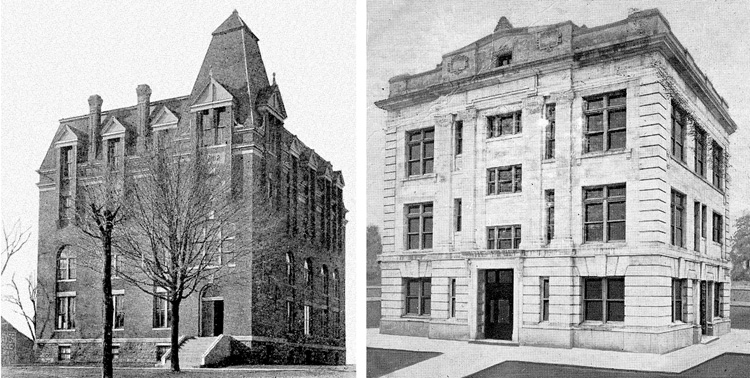
| JOHNSON COUNTY IAGenWeb Project |
Copyright 2004
By Bob Hibbs

Postcard
images of these University of Iowa buildings draw blank stares from many
long-time locals despite the
fact one still exists a few steps from Iowa Avenue. The other was destroyed by
fire in 1901, causing a monumental
scramble for classroom and laboratory space.
|
By
Bob Hibbs Images
of several University of Iowa buildings set off blank stares among some
long-time local residents, even one existing building near the heart of the
campus in central Iowa City. Their
use seems mysterious; their appearance so unfamiliar that even their very
existence as Iowa City buildings sometimes is doubted. Two
structures from photographic postcards in the author’s collection provide a
duel case in point. One is historic, that is, no longer existing; the other
rests a few steps off Iowa Avenue at the north edge of downtown Iowa City. The
historic building burned in 1901, so it naturally has faded from living memory.
Rather, it lives in century-old images recorded between its construction in 1882
and its demise at age 19. It
was erected specifically to house the then 12-year-old UI medical school and was
so doing when a fire struck at 2:45 a.m. March 10 during a blustery early spring
snow squall which changed into a mixture of sleet and rain 103 years ago. The
fire not only consumed Medical Building, but leveled engineering school quarters
next door in 1863 South Hall. Both structures inhabited Pentacrest in a row of
red brick structures on both north and south flanks of Old Capitol. As
the fire consumed first Medical Building, then South Hall, fear for the safety
of Old Capitol and unfinished Schaeffer Hall spread among the dozens of faculty,
students and townspeople who turned out to help battle the blaze. Most
local residents had been awakened as the town was shaken by explosions in the
chemistry laboratory in the basement of the med building setting that structure
ablaze. Only
blistered paint on Old Cap and a few charred window frames in Schaeffer
resulted, but South Hall and Medical Building which represented nearly 20
percent of all UI classroom and lab space were lost. Replacements soon sprouted,
but it was several years before the campus was back to some semblance of normal. The
first segment of the present engineering building at the top of the Washington
Street hill was occupied in 1905, providing space into which to move much of the
school’s apparatus which had been carried out of South Hall into the rain and
sleet four years earlier. The
med school, which lost its entire apparatus, mostly was crowded into University
Hospital, then located along the north face of Iowa Avenue between Linn and
Gilbert streets. Its replacement came in two parts – a labs building and a
classroom structure. Classes
were settled into a 1904 structure catty-cornered across the Jefferson-Dubuque
streets intersection from First Methodist Church. It’s been converted into
laboratories for the biological sciences now housed in two larger structures on
either flank of Dubuque Street, connected by a pedestrian overpass. The
new med school labs structure – called Anatomy Hall during its early existence
– was opened in 1902 adjacent to what would become the southwest corner of the
classroom building. This
century-old labs building – now surrounded by other structures – is located
in the center of the block serving as home to Phillips Hall and the
Congregational Church on the west face. It
now serves as the Biological Sciences Library, until recent weeks hidden away
behind construction vehicles and fencing. It is being given a clear courtyard
vista opening to the Avenue. Rather
than being lost, Anatomy Hall is now flourishing as a specialty library, while
Medical Building has perished into image archives. Both
buildings have served the university well. Next
Saturday: Joe Williams – Iowa City’s original judge. Bob
Hibbs collects local postcards and other historic ephemera and researches
history related to them.
|